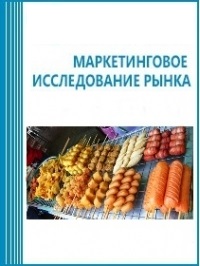



The report consists of 8 chapters.
Chapter 1 includes methodological aspects of the report:purpose, methods and resources.
In Chapter 2, there is information about volume of the catering market in Russia, market growth and key trends.
Chapter 3 includes information about consumer spendings on catering market in Russia.
Chapter 4 is dedicated to the description of competitive landscape of the catering market in Russia.
In Chapter 5, there is information about foodservice market in Russia, leaders and key players on the market and their characteristics.
Chapter 6 is dedicated to marketing particularities and to special aspects of the business running improvement.
Chapter 7 includes information about key trends and tendencies of the catering marketing in Russia, different aspects of market segmentation.
In Chapter 8, there is information about franchising process and mechanism on the catering market in Russia.
The purpose of researchThe description of a current situation and the evaluation of development prospects of the street food market in Russia. A detailed analysis of the stalls and kiosks segment.
Objectives of research1. Evaluation of the key figures of the foodservice market in Russia: market sizes, market growth rates, units and consumer spendings on foodservices.
2. Description of consumer spendings characteristics and its dynamics. Analysis of its dependence on population category and geographical aspect.
3. Characteristic of the market key trends and prospects.
4. Analysis of the market condition in federal districts.
5. Description of the competitive landscape on catering market in Russia.
6. Analysis of stalls/kiosks segment in Russia, sales dynamics, company and brand shares, prospects.
Study subjectCatering market in Russia.
Data collection and analyzing methodPaper monitoring.
The key object of the desktop research is forecasting the future catering market situation in Russia and evaluation of the present and future numerical characteristics.
Resources1. Federal Customs Service of Russian Federation, FSSS
2. DataMonitor, EuroMonitor, Eurostat materials.
3. Print and electronic business and special media, analytical surveys.
4. Internet-sources.
5. Experts’ inquiries.
6. Domestic and world market players’ materials
7. Marketing and consulting agencies reports.
8. Databases and materials of branch institutions.
9. UnitedNationsStatisticsDivision: CommodityTradeStatistics, IndustrialCommodityStatistics, FoodandAgricultureOrganization
10. InternationalMonetaryFund
11. WorldBankmaterials.
12. World Trade Organization materials.
13. Organization for Economic Cooperation and Development materials.
14. International Trade Centre materials.
15. Index Mundi materials.
16. DISCOVERY Research Group researches and its results.
Sample size and structureThe procedure of documents content analysis does not involve a calculation of the sample volume. Processing and analysis documents are available to the researcher.
| Contents | 8 |
| Tables: | 10 |
| Charts: | 10 |
| Resume | 12 |
| Chapter 1. Research unctional specifications | 13 |
| §1.1. The purpose of research | 13 |
| §1.2. Objectives of research | 13 |
| §1.3. Study subject | 13 |
| §1.4. Data collection and analyzing method | 13 |
| §1.5. Resources | 13 |
| §1.6. Sample size and structure | 14 |
| Chapter 2. Russian catering market key trends | 15 |
| §2.1. Market size | 15 |
| §2.2. Market volumes by the Federal Districts | 17 |
| §2.3. Foodservice value growth | 19 |
| §2.4. Quantity, capacity and floorspace of foodservice outlets | 22 |
| §2.5. Market prospects | 28 |
| Chapter 3. Consumer spending on foodservice | 29 |
| §3.1. Consumer spendings dynamic | 29 |
| §3.2. Consumer spending on foodservice in terms of economic performance | 31 |
| §3.3. Consumer spending on foodservice in terms of geographical aspect | 34 |
| Chapter 4. Competitive landscape | 35 |
| Chapter 5. Foodservice market landscape | 38 |
| §5.1. Market characteristics | 38 |
| §5.2. Market segmentation by sevice type | 38 |
| §5.3. Market organization by segments | 38 |
| §5.4. Segments capacity dynamic | 39 |
| §5.5. Catering facilities in segments | 40 |
| §5.6. Dynamic of changes in the number of catering facilities by segments, from December 2013 to March 2015 | 41 |
| §5.7. Segment characteristic | 43 |
| §5.8. Segment description | 43 |
| §5.9. Volume of sales and number of sales outlets | 43 |
| §5.10. Consumer audience | 43 |
| §5.11. Leaders in segment | 45 |
| 5.11.1. Stardog!s | 46 |
| 5.11.2. Brand description | 46 |
| 5.11.3. Sales outlets | 46 |
| 5.11.4. Franchising | 47 |
| §5.12. Kroshka-Kartoshka | 48 |
| 5.12.1. Segment description | 48 |
| 5.12.2. Sales outlets | 48 |
| 5.12.3. Consumer audience | 49 |
| 5.12.4. Sales outlets | 50 |
| §5.13. Teremok | 52 |
| 5.13.1. Segment description | 52 |
| 5.13.2. Sales outlets | 52 |
| 5.13.3. Sales outlets | 52 |
| 5.13.4. Main events | 53 |
| Chapter 6. Marketing particularities | 54 |
| §6.1. Special aspects of pricing formation | 54 |
| §6.2. Aspects of menu planning | 55 |
| §6.4. Restaurant and staff management | 62 |
| Chapter 7. Foodservice market trends | 67 |
| §7.1. Fast food segment developement | 67 |
| §7.2. Street food segment developement | 68 |
| §7.3. Expantion of networks on account of bedroom commodity | 69 |
| §7.4. Franchising development | 70 |
| §7.5. Geographical trends in the market | 71 |
| §7.6. Reducing the number of sales points in early 2015 | 71 |
| Chapter 8. Franchising | 73 |
The report includes 7 tables and 24 figures.
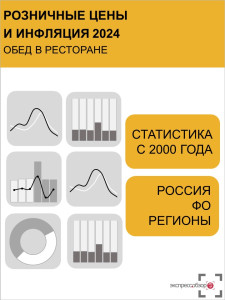 Анализ розничных цен на обед в ресторане 2024: динамика в рознице и инфляция 2000 – январь 2024. Россия, федеральные округа, регионы
Экспресс-Обзор
45 000 ₽
Анализ розничных цен на обед в ресторане 2024: динамика в рознице и инфляция 2000 – январь 2024. Россия, федеральные округа, регионы
Экспресс-Обзор
45 000 ₽
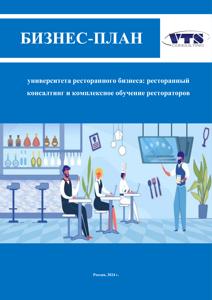 Бизнес-план университета ресторанного бизнеса: ресторанный консалтинг и комплексное обучение рестораторов (с финансовой моделью)
VTSConsulting
36 000 ₽
Бизнес-план университета ресторанного бизнеса: ресторанный консалтинг и комплексное обучение рестораторов (с финансовой моделью)
VTSConsulting
36 000 ₽
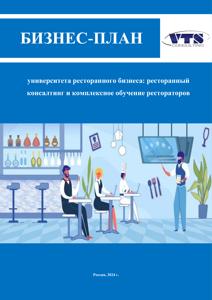 Бизнес-план университета ресторанного бизнеса: ресторанный консалтинг и комплексное обучение рестораторов
VTSConsulting
31 000 ₽
Бизнес-план университета ресторанного бизнеса: ресторанный консалтинг и комплексное обучение рестораторов
VTSConsulting
31 000 ₽
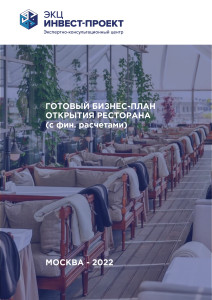 Готовый бизнес-план ресторана (с фин. расчетами)
ЭКЦ "ИнвестПроект"
34 900 ₽
Готовый бизнес-план ресторана (с фин. расчетами)
ЭКЦ "ИнвестПроект"
34 900 ₽

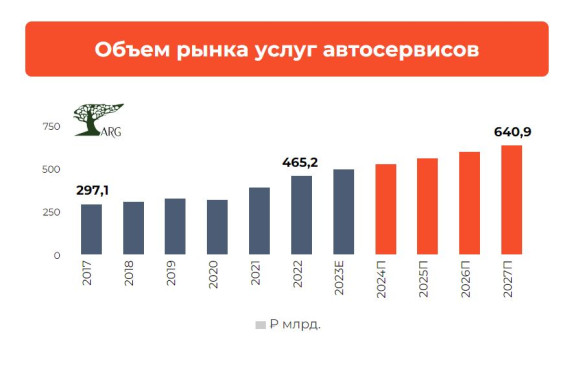 Статья, 18 апреля 2024
AnalyticResearchGroup (ARG)
Объем рынка автосервисов в России в 2027 году может составить почти ₽650 млрд.
Росту рынка способствуют проблемы с поставками запчастей, устаревание парка автомобилей и повышение цен.
Статья, 18 апреля 2024
AnalyticResearchGroup (ARG)
Объем рынка автосервисов в России в 2027 году может составить почти ₽650 млрд.
Росту рынка способствуют проблемы с поставками запчастей, устаревание парка автомобилей и повышение цен.
В 2022 году общая сумма услуг, предоставленных автосервисами населению в России, оценивалась в 465,2 миллиарда рублей, что на 17,9% превышает уровень предыдущего года. Показатель CAGR на этом рынке за период с 1994 года составил 27,5%.
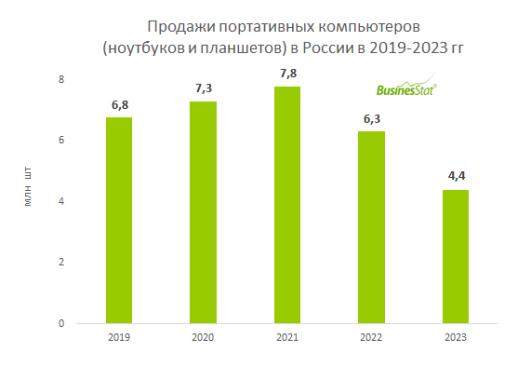 Статья, 17 апреля 2024
BusinesStat
За 2022-2023 гг в России продажи портативных компьютеров снизились на 44% относительно 2021 г и составили 4,4 млн устройств.
Уход западных компаний привел к снижению объема корпоративных закупок.
Статья, 17 апреля 2024
BusinesStat
За 2022-2023 гг в России продажи портативных компьютеров снизились на 44% относительно 2021 г и составили 4,4 млн устройств.
Уход западных компаний привел к снижению объема корпоративных закупок.
По данным «Анализа рынка портативных компьютеров (ноутбуков и планшетов) в России», подготовленного BusinesStat в 2024 г, за 2022-2023 гг их продажи в стране снизились на 44% относительно 2021 г и составили 4,4 млн устройств.
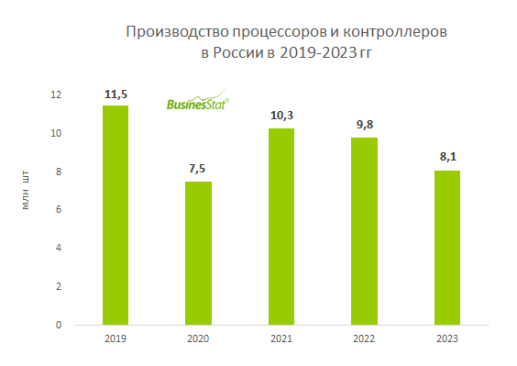 Статья, 17 апреля 2024
BusinesStat
За 2022-2023 гг выпуск процессоров и контроллеров в России снизился на 22% по отношению к 2021 г и составил 8,1 млн шт.
Сокращение производства связано с запретом западных стран на поставки в Россию компонентов, софта и оборудования, необходимых для изготовления процессоров.
Статья, 17 апреля 2024
BusinesStat
За 2022-2023 гг выпуск процессоров и контроллеров в России снизился на 22% по отношению к 2021 г и составил 8,1 млн шт.
Сокращение производства связано с запретом западных стран на поставки в Россию компонентов, софта и оборудования, необходимых для изготовления процессоров.
По данным «Анализа рынка процессоров и контроллеров в России», подготовленного BusinesStat в 2024 г, в 2022-2023 гг их выпуск в стране снизился на 22% по отношению к 2021 г и составил 8,1 млн шт. Сокращение производства связано с запретом западных стран на поставки в Россию компонентов, софта и оборудования, необходимых для изготовления процессоров и контроллеров, а также с ужесточением государством требований по локализации, к которым оказались не готовы многие игроки рынка электроники и вычислительной техники.